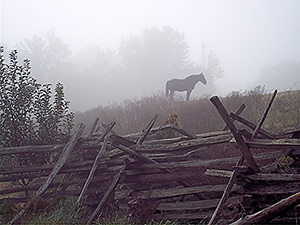Page content
Historic Farming
Livestock - Horses
Horses were the chief mode of transportation. They pulled plows, carts, and wagons. Some (the most valued) could prove a planter’s worth by their swiftness and strength in racing, a common diversion of rural Virginians. Many horses went without shoes, except on stony terrain.
Virginia horses were a mix of English, Irish, Scottish, French, and Spanish breeds. Of these, the characteristics of the Spanish Chickasaw, or Indian horse, played a dominant role. Although Virginians preferred their horses to be at least 14 hands high (4 feet, 8 inches at the shoulder), most were smaller. They usually weighed between 600 and 700 pounds. Wild horses were obtainable, but capturing and breaking them in was difficult as well as tiresome, and doing it required the use of healthy, previously trained mounts.
Horses consumed 8 to 10 pounds of corn fodder per day through the winter. When working, they might receive oats for extra energy. Most planters did not provide their animals with a pasture crop. Horses relied on wild vegetation to sustain them through the spring and summer. When a horse was required for work, it could often be found grazing on natural grasses nearby.
Horse races were frequent, sometimes spontaneous events, and horse owners placed much pride in their outcome. The most popular type of race was the quarter mile, and horses that could compete successfully in them were styled quarter horses. Wealthier planters began importing and breeding Thoroughbreds specifically for racing in the second half of the 18th century. Thoroughbreds were the offspring of English mares that had been covered by Arab, Turk, or Barb stallions.

